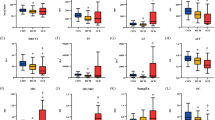Abstract
This study has aimed to develop a novel pre-diagnostic tool for primary care screening of heart disease based on multivariate short-term heart rate variability (HRV) analyzed by linear (time and frequency domain) and nonlinear methods (compression entropy (CE), detrended fluctuation analysis (DFA), Poincaré plot analysis, symbolic dynamics) applied to 5-min ECG segments. Firstly, we applied HRV analysis to separate healthy subjects (REF) from heart disease patients (PAT). Then to optimize the results, we subdivided both groups according to gender: REF (♂ = 78, ♀ = 53) versus PAT (♂ = 378, ♀ = 115). Finally, we divided REF and PAT into two age subgroups (30–50 years vs. 51-70 years of age) to consider the influence of age on HRV. Heart disease patients were classified using a scoring system based on cut-off values calculated from all HRV indices obtained from the REF. After combining the optimum indices from all different analyzing methods, sensitivities of more than 72% and a specificity of 100% in all subgroups were revealed. Nonlinear indices proved to be better for discriminating heart disease patients from healthy subjects. Multivariate short-term HRV, analyzed by both linear and nonlinear methods appears to be a suitable pre-diagnostic tool for screening heart disease in primary care settings.






Similar content being viewed by others
References
Baumert M et al (2004) Forecasting of life threatening arrhythmias using the compression entropy of heart rate. Methods Infect Med 43(2):202–206
Bigger JT Jr et al (1992) Frequency domain measures of heart period variability and mortality after myocardial infarction. Circulation 85(1):164–171
Brennan M, Palaniswami M, Kamen P (2002) Poincare plot interpretation using a physiological model of HRV based on a network of oscillators. Am J Physiol Heart Circ Physiol 283(5):H1873–H1886
Glassman AH et al (2007) Heart rate variability in acute coronary syndrome patients with major depression: influence of sertraline and mood improvement. Arch Gen Psychiatry 64(9):1025–1031
Goernig M et al (2008) Peripheral arterial disease alters heart rate variability in cardiovascular patients. Pacing Clin Electrophysiol 31(7):858–862
Greiser KH et al (2009) Cardiovascular diseases, risk factors and short-term heart rate variability in an elderly general population: the CARLA study 2002–2006. Eur J Epidemiol 24(3):123–142
Halpert I et al (1996) Reinnervation of the transplanted human heart as evidenced from heart rate variability studies. Am J Cardiol 77(2):180–183
Huang H-H et al (2008) Using a short-term parameter of heart rate variability to distinguish awake from isoflurane anesthetic states. Med Biol Eng Comput 46(10):977–984
Kamen PW, Krum H, Tonkin AM (1996) Poincare plot of heart rate variability allows quantitative display of parasympathetic nervous activity in humans. Clin Sci (Lond) 91(2):201–208
Kleiger RE et al (1987) Decreased heart rate variability and its association with increased mortality after acute myocardial infarction. Am J Cardiol 59(4):256–262
Kurths J et al (1995) Quantitative analysis of heart rate variability. Chaos 5(1):88–94
Lau S et al (2006) Low HRV entropy is strongly associated with myocardial infarction. Biomed Tech (Berl) 51(4):186–189
Maestri R et al (2007) Nonlinear indices of heart rate variability in chronic heart failure patients: redundancy and comparative clinical value. J Cardiovasc Electrophysiol 18(4):425–433
Makikallio TH et al (1999) Fractal analysis of heart rate dynamics as a predictor of mortality in patients with depressed left ventricular function after acute myocardial infarction. TRACE Investigators. TRAndolapril Cardiac Evaluation. Am J Cardiol 83(6):836–839
Malliani A et al (1991) Cardiovascular neural regulation explored in the frequency domain. Circulation 84(2):482–492
McNames J, Aboy M (2006) Reliability and accuracy of heart rate variability metrics versus ECG segment duration. Med Biol Eng Comput 44(9):747–756
Peña MA et al (2009) Applying fractal analysis to short sets of heart rate variability data. Med Biol Eng Comput 47(7):709–717
Peng CK et al (1995) Quantification of scaling exponents and crossover phenomena in nonstationary heartbeat time series. Chaos 5(1):82–87
Porta A et al (2001) Entropy, entropy rate, and pattern classification as tools to typify complexity in short heart period variability series. IEEE Trans Biomed Eng 48(11):1282–1291
Porta A et al (2007) An integrated approach based on uniform quantization for the evaluation of complexity of short-term heart period variability: application to 24 h Holter recordings in healthy and heart failure humans. Chaos 17(1):015117
Rajendra Acharya U et al (2006) Heart rate variability: a review. Med Biol Eng Comput 44(12):1031–1051
Stein PK, Deedwania P (2010) New York Heart Association Functional class influences the impact of diabetes on cardiac autonomic function. J Electrocardiol 43:379–384
Stein PK, Kleiger RE (1999) Insights from the study of heart rate variability. Annu Rev Med 50:249–261
Truebner S et al (2006) Compression entropy contributes to risk stratification in patients with cardiomyopathy. Biomed Tech (Berl) 51(2):77–82
Voss A et al (1996) The application of methods of non-linear dynamics for the improved and predictive recognition of patients threatened by sudden cardiac death. Cardiovasc Res 31(3):419–433
Voss A et al (2009) Methods derived from nonlinear dynamics for analysing heart rate variability. Philos Trans A Math Phys Eng Sci 367(1887):277–296
Wessel N et al (2000) Nonlinear analysis of complex phenomena in cardiological data. Herzschrittmachertherapie und Elektrophysiologie 11(3):159–173
Zhang J (2007) Effect of age and sex on heart rate variability in healthy subjects. J Manip Physiol Ther 30(5):374–379
Ziegler D et al (2006) Selective contribution of diabetes and other cardiovascular risk factors to cardiac autonomic dysfunction in the general population. Exp Clin Endocrinol Diabetes 114(4):153–159
Ziv J, Lempel A (1977) Universal algorithm for sequential data compression. IEEE Trans Inf Ther 23:337–343
(1996) Heart rate variability: standards of measurement, physiological interpretation and clinical use. Heart rate variability: standards of measurement, physiological interpretation and clinical use. Circulation 93(5):1043–1065
Acknowledgment
The authors gratefully acknowledge the financial support of the Deutsche Forschungsgemeinschaft (DFG, Vo505/8-1 and Vo505/8-2).
Author information
Authors and Affiliations
Corresponding author
Rights and permissions
About this article
Cite this article
Heitmann, A., Huebner, T., Schroeder, R. et al. Multivariate short-term heart rate variability: a pre-diagnostic tool for screening heart disease. Med Biol Eng Comput 49, 41–50 (2011). https://doi.org/10.1007/s11517-010-0719-6
Received:
Accepted:
Published:
Issue Date:
DOI: https://doi.org/10.1007/s11517-010-0719-6




